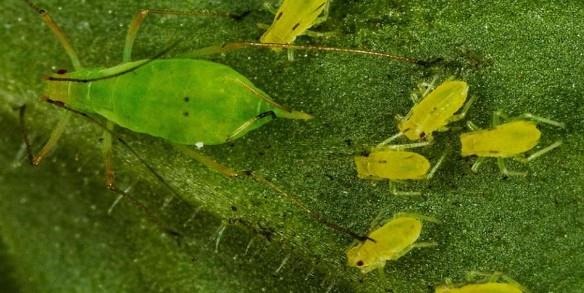Cucumber mosaic, caused by the cucumber mosaic virus (abbreviated as CMV) is a worldwide, highly infectious viral disease that affects a wide range of hosts. This disease can be devastating for farmers, causing yield loss and poor-quality crops, while drastically decreasing profit margins. This is detrimental for local food producers, because their operations and livelihood are dependent on the income from annual crop yields. The number one vector for spreading this disease is aphids. Aphids can be difficult to manage at times due to their high reproductive rates and ability to spread diseases quickly. This article will touch on various aspects of CMV including why farmers should care, the disease cycle, what symptoms to look out for, and potential disease management strategies. Understanding CMV and implementing appropriate management techniques to combat the disease will lead to improved crop yields, quality crops, and happier farmers.
Economic Importance

Cucumber mosaic virus can cause complete crop losses if it’s not detected early. Courtesy: Edward Sikora, Auburn University, Bugwood.org
Cucumber mosaic virus is a worldwide disease. It affects a wide range of regions and climates that include temperate, tropical, and subtropical conditions.
CMV can be devastating for farmers. The greatest factor is its effects on yields as well as the quality of crops. If caught and treated within a reasonable window, CMV can cause crop losses of 10 to 20%, but, sadly, if not detected soon enough, CMV can cause complete losses. In addition, infected crops are defective and are not appealing to the eye and, therefore, not able to be sold at market value. This makes consumers uninterested, leading to products and profits suffering.
Lastly, cucumber mosaic virus will increase costs significantly in order to prevent and manage the disease.
Disease Cycle

Over 75 species of aphids, including these green peach aphids, can spread cucumber mosaic virus. Courtesy: David Cappaert, Bugwood.org
First and foremost, the CMV disease cycle begins with the virus overwintering in perennial crops and weeds. In the spring, aphids feed on the infected plant material using their stylet. Over 75 species of aphids can spread CMV. Although cucumber beetles can also transmit CMV, they are not nearly as effective as aphids. CMV is able to stay in the aphid’s stylet for 2 to 3 hours. To continue the disease cycle, the aphid with CMV in its mouthpart pierces and feeds on a susceptible plant, infecting it. The virus spreads quickly through the plant, blocking its vascular system. Once infected with CMV, plants will start to show symptoms within 7 to 14 days in a favorable environment. With aphids being the primary vector of this virus, CMV spreads rapidly when aphid populations are high in warm and dry environments. In places like South Dakota, CMV is most prominent in late spring and early fall. Lastly, if infected plant material is not removed from the field, CMV overwinters, continuing the cycle.
Disease Management
One of the most effective management strategies is to buy genetically-resistant crop varieties. There are many on the market for various vegetables, ornamentals, and horticulture crops. Another approach includes the isolation of crop fields. This entails growing taller, non-susceptible crops, such as corn, to form a barrier around a vegetable field. This will delay initial infections, but it won’t prevent the disease, nor is it reasonable approach for most farms. Many may believe that with aphids as the primary vector, insecticides would work best to control CMV. Research shows that spraying aphids with insecticides is unlikely to be effective and will instead cause aphids to disperse and feed more widely. In the end, more crops are infected, and the disease spreads.
An essential step in the disease management of cucumber mosaic virus is to remove and destroy infected plants. In addition, pulling weeds that are susceptible to CMV is crucial. Some weeds to look for include burdock, catnip, flowering spurge, horse nettle, jimsonweed, nightshades, pigweed, and pokeweeds, although there are many others. Many farmers leave weeds to die and place nutrients back into the soil, but this is an easy way for CMV to overwinter in a field and easily infect plants the next spring. Lastly, one management procedure that could be incorporated on a farm is to grow nectar-producing flowers that attract aphid predators, such as ladybugs. This will help reduce numbers in aphid populations, but it will not stop the disease from spreading.
Conclusion
Cucumber mosaic virus is extremely infectious and can impact a wide range of plants in various environments. The diversity of regions in which CMV can occur makes it detrimental to local food operations. CMV can drastically impact crop quality and yields; this hurts producers and consumers by limiting the number of crops available for purchase. Since CMV is spread through aphid populations, it tends to advance rapidly within crop fields, which makes the virus hard to manage without obtaining significant crop loss during a growing season. Isolating crop fields, removing and destroying infected plants, as well as rouging susceptible weeds can all help prevent the occurrence of CMV. Growing nectar-producing flowers can attract predators of aphids, helping to decrease the current aphid population and helping to manage disease spread. However, these methods do not prevent the virus, but can mitigate infections. All in all, selecting genetically-resistant crop varieties to plant in the field is the best option for local food producers. Taking the appropriate steps needed to prevent CMV will lessen farmers’ risk of having an outbreak and losing crops. Therefore, it is important to understand CMV and apply the necessary management techniques.
Source :